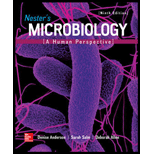
Nester's Microbiology: A Human Perspective
9th Edition
ISBN: 9781259709999
Author: Denise G. Anderson Lecturer, Sarah Salm, Deborah Allen
Publisher: McGraw-Hill Education
expand_more
expand_more
format_list_bulleted
Concept explainers
Question
Chapter 12, Problem 2SA
Summary Introduction
To review:
The differences between molds, mushrooms, and yeasts.
Introduction:
Expert Solution & Answer
Want to see the full answer?
Check out a sample textbook solution
Students have asked these similar questions
If the spores of a fungus are haploid and divide to form the hyphae by mitosis, then what are the cells of the hyphae (haploid, diploid, tripled) ?
How is a water mold like a fungus; how is it different?
How does the body of a yeast differ from that of a mold?
Chapter 12 Solutions
Nester's Microbiology: A Human Perspective
Ch. 12 -
1. What are the major differences between a...Ch. 12 - Prob. 2SACh. 12 -
3. Why are few lichens found in industrial...Ch. 12 - Prob. 4SACh. 12 - Prob. 5SACh. 12 - Prob. 6SACh. 12 -
7. Compare and contrast the organisms that cause...Ch. 12 - Name a disease for which humans are an...Ch. 12 - Prob. 9SACh. 12 -
10. Explain how an insect might act as a...
Ch. 12 -
1. Members of this group have chitinous cell...Ch. 12 - Prob. 2MCCh. 12 - Prob. 3MCCh. 12 - Prob. 4MCCh. 12 - Prob. 5MCCh. 12 - Prob. 6MCCh. 12 - The current phylogeny of eukaryotes is based upon...Ch. 12 -
8. All algae have
a) chlorophyll a.
b) cell walls...Ch. 12 - Prob. 9MCCh. 12 -
10. Which of the following statements regarding...Ch. 12 - Prob. 1ACh. 12 - Paper recycling companies refuse to collect paper...Ch. 12 -
1. If you discovered a new type of nucleated cell...Ch. 12 - Prob. 2CT
Knowledge Booster
Learn more about
Need a deep-dive on the concept behind this application? Look no further. Learn more about this topic, biology and related others by exploring similar questions and additional content below.Similar questions
- What are the major structural differences between a mold rhizoid (mycelium) and the “mushroom” (sexual reproductive structure)?arrow_forwardWhat maintains the shape of a fungal spore?arrow_forwardYeast are unicellular fungi that reproduce by budding (Fig. 8.4.). Identify individual yeast cells and locate a budding cellarrow_forward
- What are types of reproduction in fungi?arrow_forwardWhat is the role ( producer, consumer, or decomposer) of a fungi in nature ?arrow_forwardWhich of the following statements about fungi is FALSE? O 1) They may cause human disease. O 2) fungi are photosynthetic. O3) fungi are eukaryotes. O 4) Fungi include yeasts and molds. O 5) Some fungi are unicellular.arrow_forward
- How is the structure of yeast hyphae different from that of molds?arrow_forwardDescribe two ways in which fungal spores arise. Sexual spores= zygosporesarrow_forwardSome fungi exhibit dimorphism, i.e. they can exist in both yeast and mold form. Why is this so? What advantage does this provide for these organisms?arrow_forward
- What are the differences of yeast from other kingdom?arrow_forwardThe Fungi are a kingdom driven by their relationships with other taxa. I) What two major roles do fungi play? ii) Describe one example of a specific fungal species that effects humans. Iii) Describe one example of a specific fungal species that effects plants.arrow_forwardYou have been asked to consult for a biotech company that is seeking to understand why some fungi can live in very extreme environments, such as the high temperatures inside naturally occurring hot springs. The company has isolated two different fungal species, F. cattoriae and W. gravinius, both of which can grow at temperatures exceeding 95°C. The company has determined the following things about these fungal species (see attached image) By sequencing and examining their genomes, the biotech company hopes to understand why these species can live in extreme environments. However, the company only has the resources to sequence one genome, and would like your input as to which species should be sequenced and whether you believe a shotgun strategy will work in this case.arrow_forward
arrow_back_ios
SEE MORE QUESTIONS
arrow_forward_ios
Recommended textbooks for you
 Biology (MindTap Course List)BiologyISBN:9781337392938Author:Eldra Solomon, Charles Martin, Diana W. Martin, Linda R. BergPublisher:Cengage Learning
Biology (MindTap Course List)BiologyISBN:9781337392938Author:Eldra Solomon, Charles Martin, Diana W. Martin, Linda R. BergPublisher:Cengage Learning

Biology (MindTap Course List)
Biology
ISBN:9781337392938
Author:Eldra Solomon, Charles Martin, Diana W. Martin, Linda R. Berg
Publisher:Cengage Learning